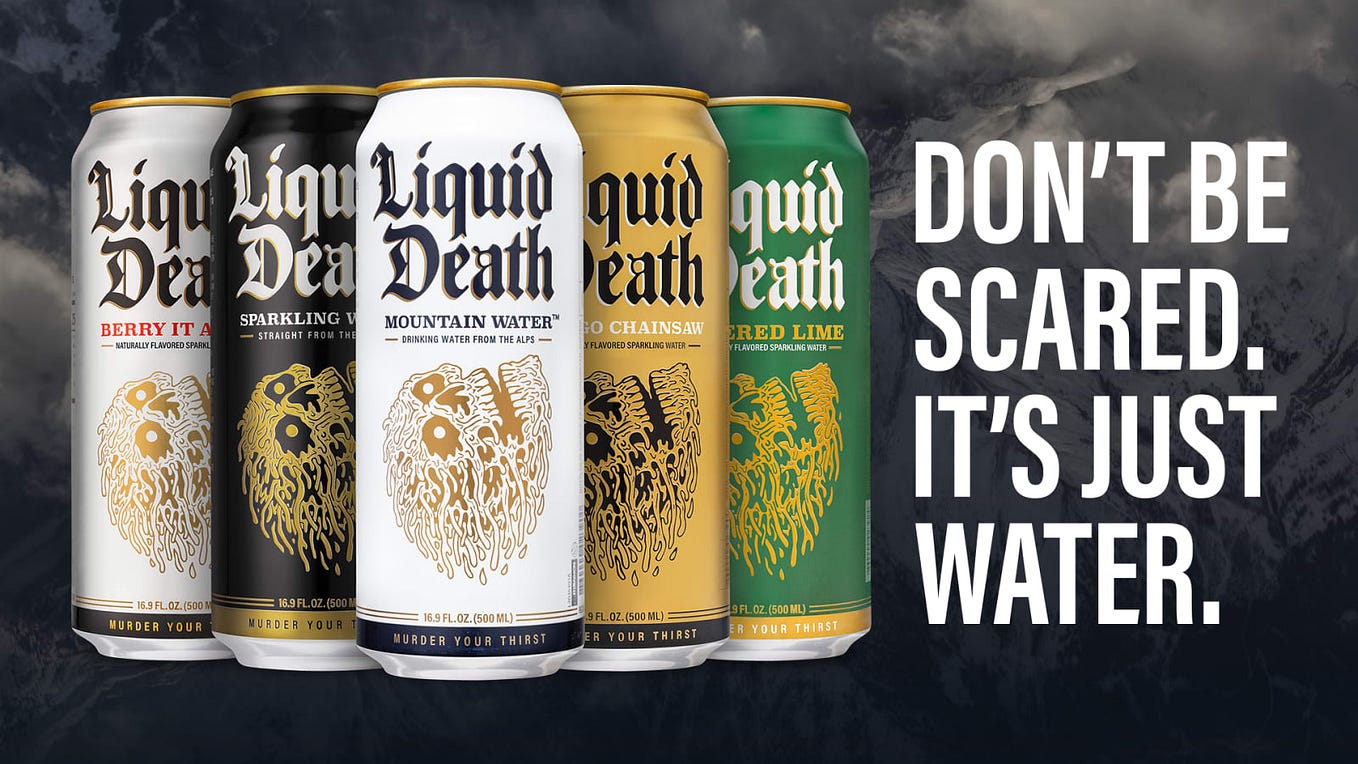The Anti-Brand Playbook

Liquid Death Didn’t Sell Water—They Sold Rebellion. Here’s Why It Worked.
Let’s start with water. It’s a basic product, but the bottled water industry is anything but simple. Dominated by major brands like Aquafina, Nestlé, and Evian, the market seemed impenetrable to newcomers. But in 2019, Mike Cessario and his team at Liquid Death changed that by launching a beverage company with a unique approach.
Liquid Death wasn’t just about selling water—it was about challenging an entire industry with a bold and unconventional brand. The company rebranded water as something edgy and rebellious, using humor and sarcasm to break through the noise. The idea was simple: kill plastic and sell water in aluminum cans, but with a rock-and-roll edge.
What set Liquid Death apart was its branding, driven by Cessario’s belief that the brand itself is the differentiator. "The difference between products is always subtle," he said. And so, Liquid Death embraced humor, targeting a younger demographic who were tired of conventional marketing.
In its first year, Liquid Death made a strong debut with $3 million in sales. By 2024, that number surged to $333 million, a staggering 11,000% growth. With over 11 million followers between Instagram and TikTok, the brand quickly became a cultural phenomenon.
One of the most pivotal moments in Liquid Death’s story was its ability to turn humor and authenticity into a viral marketing machine. The brand didn’t just jump on the latest trends; it created its own. The skateboard campaign, for instance, wasn’t just an edgy stunt. It was perfectly executed viral marketing that used Tony Hawk’s blood-infused ink to sell a limited run of skateboards. The viral moment wasn’t a fluke. It was a calculated move designed to spark conversation, generate attention, and build an authentic connection with a younger, engaged audience.
But it wasn’t just about getting attention. Cessario’s genius was in converting that attention into a pitch—a pitch for both consumers and investors. He understood that the brand’s authenticity and real connection with its audience were key selling points. This wasn’t just another product—it was a movement. He used this momentum to attract early-stage investors, proving that his brand wasn’t just a gimmick, but a product with real staying power in a crowded market.
As a result, Liquid Death’s brand identity became its greatest asset, not the product itself. The water inside the can wasn’t drastically different from any other brand. What set it apart was its ability to connect with consumers in a meaningful way, creating loyalty through authenticity and humor. And this connection translated into investment and growth, proving that with the right strategy, even the most saturated markets are ripe for disruption.
The Unhinged Growth Hack
"Skulls, Blood, and Aluminum: The Insane Marketing Playbook That Made Water Cool Again"
Key Takeaways from Liquid Death’s Strategy:
• Efficiency in capturing virality: Cessario’s ability to create campaigns that capture attention and turn those views into a pitch for investors is what set him apart.
• Authenticity is key: The success of Liquid Death is rooted in its genuine brand identity, not in the novelty of the product itself.
• Branding as the differentiator: The product was subtle, but the brand was bold, making it stand out in a crowded market.
• Turning viral moments into business: Liquid Death’s success shows that capturing a cultural moment is one thing, but turning it into a sustainable business model requires vision and strategic execution.
Why Authentic Branding Disrupts the Market
The lesson here isn’t just about having a good product—it’s about building a strong brand identity that resonates with your audience. Cessario’s success wasn’t just in selling water; it was in building a cultural phenomenon around it, turning a simple product into something people felt emotionally connected to. And once that connection is made, you’re not just selling water; you’re selling a story, a lifestyle, and an identity that consumers want to be a part of.
In a saturated market, where products often feel indistinguishable from one another, the authenticity of your brand becomes the true differentiator. And when that authenticity is aligned with your vision, it becomes something that not only captures consumer attention but also appeals to investors who are looking for scalable, disruptive ideas.
Just like David and Goliath, the giants of traditional markets may seem too big to challenge. But with the right vision, brand identity, and authentic marketing, it’s not about having the best product—it’s about having the best narrative that resonates with people in a way that feels real, authentic, and aligned with today’s values.
https://www.youtube.com/watch?v=iXjhNZlqexs&t=34s